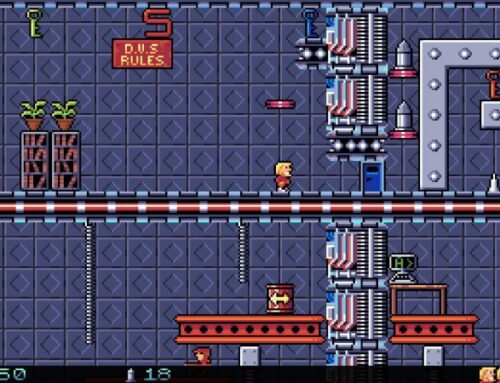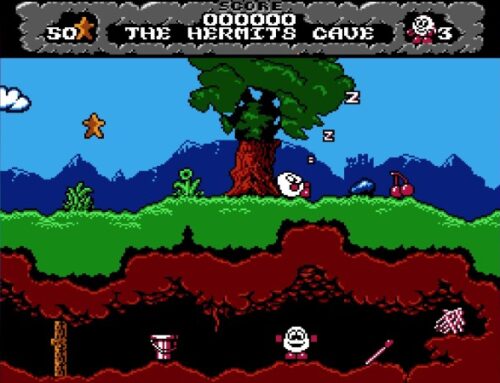Last week, we reported that Microsoft and Atari were in the process of rereleasing a selection of classic flight simulators and wargames for modern computers via Steam. At the time, F-15 Strike Eagle and The Ancient Art of War in the Skies had already been released, with Solo Flight, Harrier Jump Jet and Dogfight set to follow.
Now, those remaining titles have been added to the mix — so I thought I’d give a go to one that I never played back in the day: Solo Flight.

For the unfamiliar, Solo flight is a civilian flight simulator originally released by MicroProse in 1983. It was developed by Sid Meier, a developer best known today for his successful series of Civilization turn-based strategy games, but renowned back in the day for being a developer of some superb flight simulators.
Most of these were military jet flight sims, so Solo Flight stood out as a rare example of virtual civilian flying — its only real rival at the time was Sublogic’s Flight Simulator II (the game that would later become Microsoft Flight Simulator), which released for Apple II the same year Solo Flight first hit Atari 8-bit home computers. Both games ended up ported to a variety of different platforms, including IBM PC; unsurprisingly, Solo Flight’s PC version is the one that has been rereleased on Steam rather than any of the other versions.
What that means in practical terms is that you can look forward to putrid turquoise and pink visuals using CGA’s “cool” colour palette of four colours — but honestly speaking, it doesn’t actually matter too much, since much of your time in Solo Flight is spent staring at your instrument panel rather than looking out of the window. Much like real flying, in fact.

Solo Flight features two main modes of play: a free flight mode with an optional instructor who will initially talk you through a simple takeoff, circuit and landing at an airport in one of the six American states available to explore in the package, and a Mail Pilot mode, which challenges you to deliver bags of mail between different airports while dealing with increasingly perilous weather and mechanical emergencies on the higher difficulty levels.
Interestingly, unlike Flight Simulator II, Solo Flight doesn’t purport to simulate any specific aircraft. Instead, its free flight mode is based on objectives set by the US Air Force when training pilots to fly the T-37 “Tweet” — MicroProse president “Wild” Bill Stealey showing his military background there, methinks — while the Mail Pilot mode is inspired by aircraft of the late 1920s and 1930s, with specific reference drawn from the Ryan S-T series and the famous “Spirit of St. Louis”, which was flown across the Atlantic in 1927.
In the manual’s words, though, “the simulation reduces slightly some of the more dangerous characteristics of these famous planes, as well as adding a few more instruments to aid flight and navigation”. In other words, you shouldn’t expect complete realism from Solo Flight — but you can expect quite a bit more in the way of depth than many other attempts at flight simulation from the period.

Solo Flight’s gameplay unfolds from a third-person perspective rather than giving you a view straight out of the cockpit window. Despite this, you have a full instrument panel beneath the main view window, allowing you quick and easy access to a variety of information including throttle, airspeed, altitude, heading and vertical speed. Your plane is also equipped with radio navigation equipment (albeit in rather simplified form compared to Flight Simulator II’s very realistic approach) allowing you to use the VOR radio stations in each state to assist with finding your way around.
Graphical detail is extremely sparse, as you might expect from a 1983 game, but sufficient to allow you to get your bearings visually once you get a feel for what is where in each state. Airfields are represented as black wireframe outlines, while cities are shown as flat three-dimensional areas marked with dotted lines, and the VOR stations can be seen as tall white towers dominating the landscape. The screen update is remarkably smooth for a game of the time, allowing for precise manipulation of the controls and a decent sensation of movement within the engine’s technical limitations.
Solo Flight’s flight model is not a patch on Flight Simulator II’s seriously impressive realism, but it does include a number of nods to realism that weren’t normally seen in sims of the period. Notably, controlling one’s altitude is a case of manipulating both throttle and pitch, and it’s also possible to glide down to an airport if your engine cuts out in mid-flight — or indeed if you turn it off to deliberately create this scenario for yourself.

The third-person perspective places deliberate limitations on what you can actually do with the aircraft — you won’t be doing any aerobatics, for example — but Solo Flight does do a good job of recreating the rather sedate, gentle feel of civilian aviation in a low-powered aircraft. It deliberately eschews the 1:1 scale of Flight Simulator II’s map, though, allowing you to fly between distant airports in a matter of moments instead of minutes or hours of real time; purists may baulk at this somewhat, but it does mean you can concentrate on the game’s main attractions, which are takeoffs, landings and radio navigation between different locations.
In the free flight mode you can, of course, fly wherever you want in any of the available states, but in Mail Pilot mode you’re challenged to deliver five bags of mail as quickly as possible. Upon starting the game, you can load up with as many mailbags and as much fuel as you want, but overloading your aircraft will make it difficult or even impossible to control; in the states that are more prone to bad weather, this can make life very difficult indeed. In most cases it’s more practical to take one or two bags and plot as efficient a route as you can.
On the easier difficulty levels of Mail Pilot, it’s a fairly straightforward case of simply trying to fly efficiently and land safely. On harder difficulties, though, you’ll be beset by changing weather conditions — with wind represented by your plane being forced to turn without you touching the controls, and reduced visibility requiring you to rely on your instruments — as well as random mechanical failures. You can actually practice the various mechanical failures in the free flight mode, too — it’s good to get to grips with what to expect from each of them before trying the harder Mail Pilot challenges!

Solo Flight is simple and exceedingly ugly by modern standards — but give it a chance and you’ll find a surprisingly compelling, enjoyable and satisfying experience. The free flight mode is great for chilling out with, while the Mail Pilot mode offers a fun challenge with which you can test your skills and try to beat your own high scores. While it’s never going to stand up to more modern flight sims — or indeed anything MicroProse themselves put out later in the ’80s and throughout the early ’90s — it is a game I would argue is still worth spending a bit of time with today.
In fact, I’m off to do that right now. The mail must get through!




